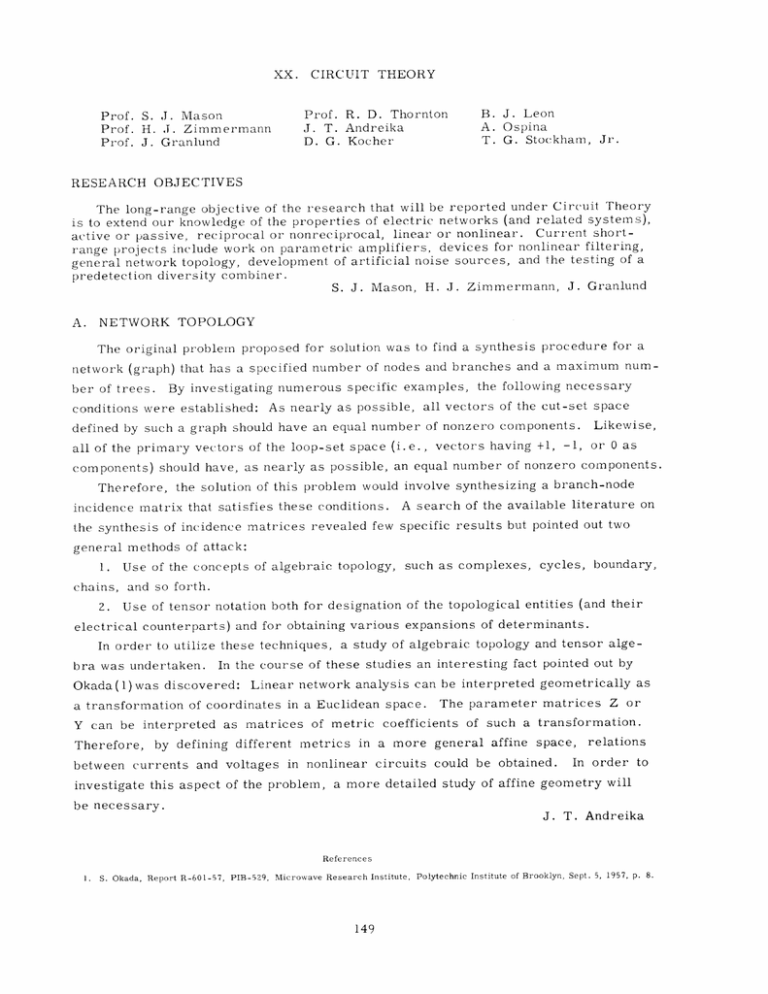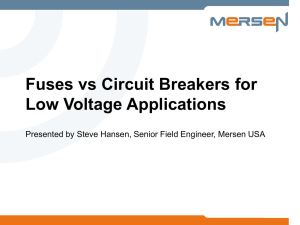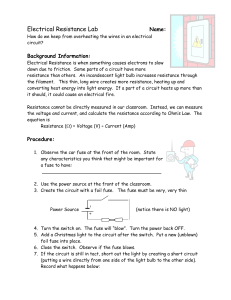XX. CIRCUIT THEORY B. J. Leon
advertisement

XX. Prof. S. J. Mason Prof. H. J. Zimmermann Prof. J. Granlund CIRCUIT THEORY Prof. R. D. Thornton J. T. Andreika D. G. Kocher B. J. Leon A. Ospina T. G. Stockharn, Jr. RESEARCH OBJECTIVES The long-range objective of the research that will be reported under Circuit Theory is to extend our knowledge of the properties of electric networks (and related systems), active or passive, reciprocal or nonreciprocal, linear or nonlinear. Current shortrange projects include work on parametric amplifiers, devices for nonlinear filtering, general network topology, development of artificial noise sources, and the testing of a predetection diversity combiner. S. J. Mason, H. J. Zimmermann, J. Granlund A. NETWORK TOPOLOGY The original problem proposed for solution was to find a synthesis procedure for a network (graph) that has a specified number of nodes and branches and a maximum numBy investigating numerous specific examples, ber of trees. conditions were established: the following necessary all vectors of the cut-set space As nearly as possible, defined by such a graph should have an equal number of nonzero components. all of the primary vectors of the loop-set space (i.e., vectors having +1, -1, Likewise, or 0 as components) should have, as nearly as possible, an equal number of nonzero components. Therefore, the solution of this problem would involve synthesizing a branch-node incidence matrix that satisfies these conditions. A search of the available literature on the synthesis of incidence matrices revealed few specific results but pointed out two general methods of attack: 1. chains, 2. Use of the concepts of algebraic topology, such as complexes, cycles, boundary, and so forth. Use of tensor notation both for designation of the topological entities (and their electrical counterparts) and for obtaining various expansions of determinants. In order to utilize these techniques, a study of algebraic topology and tensor algebra was undertaken. In the course of these studies an interesting fact pointed out by Okada(1)was discovered: Linear network analysis can be interpreted geometrically as a transformation of coordinates in a Euclidean space. Y can be interpreted Therefore, between as matrices of metric The parameter matrices Z or coefficients of such a transformation. by defining different metrics in a more general affine space, currents and voltages in nonlinear circuits could be obtained. investigate this aspect of the problem, relations In order to a more detailed study of affine geometry will be necessary. J. T. Andreika References 1. S. Okada, Report R-601-57, PIB-529, Microwave Research Institute, 149 Polytechnic Institute of Brooklyn, Sept. 5, 1957, p. 8. (XX. CIRCUIT THEORY) B. PARAMETRIC AMPLIFICATION Developments in the microwave field have led to a renewal of interest in parametric amplifiers (1). In these amplifiers a circuit element, such as a capacitor, is varied by an external source that is independent of the electric signal that is to be amplified. Power flowing from the external source into the load is controlled by the desired signal. At present, no general study of the circuit properties of such an amplifier is available. A study has just been started with the objective of investigating and deriving the properties of a single time-variant reacCO (I+ycos ad) TIME-VARIANT tive element in the environment of lumped, linear, finite, passive, and bilateral ele- CAPACITOR ments. CONTROLLING REACTIVE SOURCE It is hoped that at the end of this investigation we shall be able to state NETWORKLOAD limitations on gain and bandwidth, and to Fig. XX-1. determine the need for undesired fre- Basic parametric amplifier. quency components in the output of the circuit shown in Fig. XX-1. When a capacitor that varies at a frequency wo, is placed in a circuit with an elec- tric source at frequency wl, are generated. These, o electric components at frequencies w 11 and Wl1 - wo in turn, react with the capacitor to give the additional frequency , and so on. Therefore, any investigation of such a device requires the 1 Zo 2 study of a multiple-frequency system. There are three approaches to this problem. First, there is a strictly time-domain approach. Second, there is the time-variant transform, H(jw1 t), suggested by Zadeh (2). Third, there is a strictly frequency-domain approach. A time-domain attack is useful for simple systems, but if the reactive network is to have any generality, this approach will undoubtedly prove too complex mathematically. One of the other two methods, the use of a frequency-domain approach, may prove useful. B. J. Leon References 1. H. A. Haus, The kinetic power theorem for parametric, longitudinal, electronbeam amplifiers, Nov. 11, 1957 (submitted for publication). 2. L. Zadeh, Frequency analysis of variable networks, C. A SIMPLE EXAMPLE OF NONLINEAR FILTERING Proc. IRE 38, 291 (1950). If a linear filter is used to remove a signal from noise when the two have nearly identical power spectra, not much gain in signal-to-noise ratio is achieved. 150 Under (XX. CIRCUIT THEORY) certain circumstances, nonlinear devices can be made to single out properties of the noise or signal to achieve a better separation. An example of this fact was pointed out by the following experiment. A noise waveform was generated by passing a square wave with independent, random axis crossings through an RC differentiating circuit with a time constant of approximately 50 tsec. The resulting exponential-pulse noise was then added to a music signal that was lowpass-filtered with a high-frequency cutoff of 3. 2 kc. Ideally, the noise could be entirely eliminated in three steps, as follows: 1. By passing the signal plus noise through a linear filter that converts the exponential-noise pulses into impulses. 2. By clipping the resulting signal to remove the impulses. 3. By passing the signal minus the impulses through an inverse linear filter to regain the original signal minus the noise. A device for approximating these three steps was designed, and preliminary tests have been made. The filter required in step 1 could only be approximated and therefore did not produce true impulses, but rather short spikes of large amplitude. As a result of this limitation, the clipping process removed a portion of the impulse energy, and The filter recovered plainly intelligible therefore the noise was partially removed. speech and music from a noise level that was sufficiently high to make it barely perceptible to the ear. Quantitative results and a more detailed discussion of the theory will be given later. T. G. D. THERMAL INTEGRATING Jr. MULTIPLIER For correlation, convolution, average-power determinations, sary to find the average value of the product of two functions. heating to perform these operations, and so on, it is neces- If we utilize thermal the integration and multiplication can be carried out simultaneously in a relatively simple manner, might be more difficult. Stockham, Professor S. J. whereas the separate operations Mason suggested that a doubly excited bridge might be used to determine the average product of two variables. This report will describe the practical embodiment of this idea. The basic circuit is shown in Fig. XX-2. tional to the average product of v 1 and v 2 . The aim is to develop an output propor- The four arms of the bridge are fuses whose resistances are given very accurately by rf =r + pI -22 where I ° and r are constants, 0 0 (1) .2 and p = if. rf is the power dissipated in the fuse. fIf 151 (XX. CIRCUIT THEORY) Fig. XX-2. Basic thermal integrating multiplier. a for ac 1 b for de a for ac m for de 2 M = average-reading meter 1 2 Expression 1 is accurate within approximately ±0.2 per cent for rf/ro < 1.2. 10-ma fuse, the value of r lies between 200 and 250 ohms, and Io is approximately r (Note that if we solve for rf in Eq. 1 we have rf = , and thus rf = 0o 11 ma. [i.e., For a 2 2 the fuse blows] for if = I rent because Eq. Actually, I fo0 is slightly larger than the rated fuse cur- 1 is not accurate when the heating becomes excessive.) The thermal time constant of the fuse is a few tenths of a second. In Fig. XX-2 the fuses labeled "s" (with resistance s) have currents that are proportional to the sum of v 1 and v 2 ; the fuses labeled "d" (with resistance rents that are proportional to the difference of v 1 and v 2 . d) have cur- Since the heating of the fuse depends upon the square of the fuse current, the bridge will be unbalanced, with s proportional to the average value of the product of v 1 and v 2 . unbalance of the bridge, d To determine the a de voltage is applied across one diagonal of the bridge, and the dc voltage that appears across the other diagonal of the bridge is measured by an average-reading de meter. If we insist that v 1 and v 2 have no de components, reading will be proportional to the average value of the v 1 2 product (v 1 2 ). the meter The limita- tion that v 1 and v 2 have no average values is not very serious, since the average values of a given waveform can be subtracted and multiplied separately by using relatively simple techniques. In the circuit of Fig. XX-2 the ac resistances of the sources v I and v 2 are equal to a; the dc source resistance is b; and the meter resistance is m. The fuses have the same resistance for both ac and dc, which is given by s or d. Solving for the meter current, we find that Im m V -10+B A (v A1(VV v+v 2 ) '\\/\ +CV ok 22/\/1 vv 12 (2) )2 where 152 (XX. 2 s) Sb (m +ad) + (m (b 4 (a + s) 2 (a + d) s s) (b + d) CIRCUIT THEORY) (a I2 sd - m 2 [(b + s) (m +d) + (m + s) (b +d)] I0 If k were a constant independent of v 1 and v 2 , we would have an ideal average- reading multiplier, but since s and d depend somewhat on v 1 and v 2 , k will not be absolutely constant. By judicious choice of circuit parameters, made to be practically constant; typically, k can be k will vary by less than ±0. 5 per cent from If we approximate Eq. 2 for a a constant value for reasonable values of vl and v2. judicious choice of variables, however, we find I V with m,b > 10a; so = d (3) VV 2 = 4(b+a) (m+a) aI = a; s = (1.00 ± .05)s If we use a 10-ma fuse (I = 10 ma, s = d 2 m xVl m = 2K, we have Im z 10 v1V2Vamp if fuse burnout). ; and d = (1.00 ± .05)d with V /b = 2 ma and = 250 ohms), 2 +v 4a 2 < 16 milliwatts (to prevent errorc: and The error involved in neglecting B and C will be less than 0.5 per cent for this choice of circuit values. Thus we have a possibility of building an accurate average-reading multiplier with a practically unlimited frequency response and with only A practical circuit, shown in a few milliwatts of power required from each source. Fig. XX-3, has an over-all accuracy of approximately ±1 per cent. Any small metallic conductor can be used to replace the fuses, V 2 o C ba d s d L M Fig. XX-3. A practical form of Fig. XX-2. 153 but a fuse is (XX. CIRCUIT THEORY) relatively cheap and requires only a few milliwatts of power to change its resistance 10 per cent. It is necessary to measure the characteristics of a number of fuses and select a matched set of fuses to achieve satisfactory operation. If we match I for the o four fuses within approximately 0.2 per cent, good operation is possible. Furthermore, the amplitudes of v 1 and v 2 must be sufficiently small so that the fuse resistance does not change by more than approximately ±5 per cent from some average value. Note that the resistance of the fuse is a relatively constant parameter, and hence this circuit has advantages over a similar circuit that uses diodes which must be accurately matched. R. D. 154 Thornton







